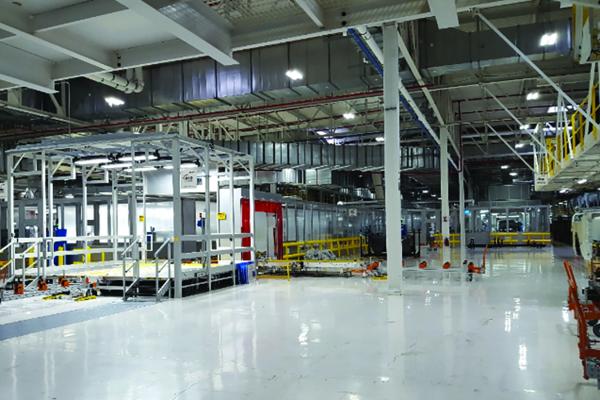Chillers
The Sterling Heights facility, producing jet engines for the U.S. Army, has undergone extensive overhauls and re-tooling in the last decade. In 2010, Stellantis announced it would invest nearly $850 million in a new state-of-the-art paint shop at the SHAP Site, as well as the installation of new machinery, tooling and material-handling equipment. The following year, the company added another $165 million to the investment to build a one million-square-foot body shop.
Schoeneck Containers, Inc. (SCI) is a company that thinks a lot about its future – and how to continue to maintain a long track record of profitability and reliability while meeting a growing demand for its quality plastic containers for customers throughout North America. It’s the kind of thinking driving the decision to install a closed-loop adiabatic fluid cooler and central chiller with free-cooling capabilities at the company’s new 250,000-square-foot production facility in Delavan, Wisconsin.
[ Read Full Story ]
Industrial automation and process applications requiring a chiller or heat exchanger can come in all types of shapes and sizes, and cooling capacity demands can range from a few hundred Btu/hr. for bench top lab equipment to many million Btu/hr. for laser applications. Chiller sizing for large-scale end users such as beverage, chemical or plastics manufacturing usually will demand central systems to achieve the massive cooling capacity requirements compared with small- to medium-range point of use automation applications. These unique differences become more challenging for original equipment manufacturers (OEMs) as machine designers must anticipate a wide range of end-user operating environments and operator skill levels when specifying chillers or heat exchangers in contrast to end-user facilities where cooling capacity requirements are location specific and operator skill levels are known.
[ Read Full Story ]
At the company’s production plant employees manufacture a complete range of engineered, high-performance polymers. At the heart of the operation are numerous extrusion lines and related equipment that operate 24 hours a day, five days per week to produce and ship as much as five million pounds of high-performance polymer pellets each month. The process of producing pellets begins when the rotating screw on each extruder accepts a carefully calibrated mix of thermoplastic materials, as well as additives, from a hopper and pushes the mixture into the extruder’s barrel.
[ Read Full Story ]
Do water-cooled chiller plants still deliver lower utility bills? Today, many chiller plant energy analyses carefully account for energy costs, and even energy escalation rates – a factor that projects how fuel costs will increase over time, while ignoring water and wastewater costs associated with cooling towers. While highly effective at transferring heat, cooling towers consume millions of gallons of water each year through the process of evaporation, drift, and blowdown. With the rising cost of water and wastewater, this omission can result in an incomplete picture for the building owner.
[ Read Full Story ]
The 2019 AEE World Energy Conference and Expo was held September 25-27 at the Walter E. Washington Convention Center in Washington D.C. The event featured 14+ tracks, 56 sessions, over 260 individual speakers, and 62 exhibitors. Both Chiller & Cooling Best Practices and Compressed Air Best Practices® Magazines were pleased to be in the literature bins at the 2019 AEE World!
[ Read Full Story ]
The chilled water is generated in the central plant and then transported through a piping network to cooling coils (air handlers), or to point of end-use in processes. Facility directors and energy managers are always chasing multiple goals - satisfying all the customers, maintaining a high-level of reliability and minimizing energy spends with varying demand and weather. Therefore, many modern plants employ a good chiller optimization package such as Hudson Technologies’ SMARTenergy OPS® in conjunction with Building Automation Systems (BAS) to optimize the chiller plants.
[ Read Full Story ]
Have you ever woken in the middle of the night in a cold sweat wondering if your plant is using more energy than it should, putting you at a disadvantage as compared to your competition? Even if your energy monitoring or energy management system is in place you may not have the required insight to improve your performance and keep you competitive.
[ Read Full Story ]
Absorption chillers have been around for more than 75 years, with several thousand chillers operating successfully all over the world today. Yet myths about cost, operation and performance surround this technology, particularly in North America. Look beyond the myths and you’ll discover absorption cooling technology can be efficient, cost-effective, flexible and reliable.
[ Read Full Story ]
Commercial buildings in the United States will be looking to replace centrifugal chillers as many are near or past their median replacement life of 25 years. This becomes apparent when you consider nearly half of all commercial buildings were constructed before 1980 according to data from the U.S. Energy Information Administration. The same can be said of buildings on American college campuses, which according to the same data, more than half of which were built before 1990. Bottom line — if you’re a commercial building owner or a facility manager/director in the United States, you may need to replace a chiller.
[ Read Full Story ]
Chiller & Cooling Best Practices Magazine interviewed Paul Heston (General Manager) and Tom Strock (Chief Engineer) from Hydrothrift Corporation.
In a nutshell, where workers are exposed to harmful chemicals, they must have eyewash and safety shower stations to decontaminate themselves in the event of a spill or splash. A variety of industries, including petrochemical, chemical, metal fabrication and laboratories, must plan for this contingency. The ANSI Z358.1 Standard specifies the water used for these purposes must be tepid or within a site-specified range. This means in colder climates, water must be heated, and in hotter climates water must be cooled.
[ Read Full Story ]

